"Cherishing Little Steps - A Haven for Baby and Family Journeys"
Nurturing Creativity in Young Children: Ideas and Inspiration
Imagine a world where creativity knows no bounds, where young minds flourish with imagination and innovation.
How can we nurture this boundless potential in our children? Through a carefully crafted blend of activities and environments, we can cultivate a fertile ground for creativity to blossom.
From the stroke of a paintbrush to the sway of a dance, each experience holds the key to unleashing a world of endless possibilities for our little ones.
Key Takeaways
- Designate a creative space at home to foster imaginative play and exploration.
- Encourage unstructured play to stimulate creativity, problem-solving, and autonomy.
- Integrate arts, crafts, storytelling, and writing to enhance problem-solving and self-expression.
- Blend technology with creative activities to promote innovation, critical thinking, and a balanced approach.
Importance of Creativity in Childhood
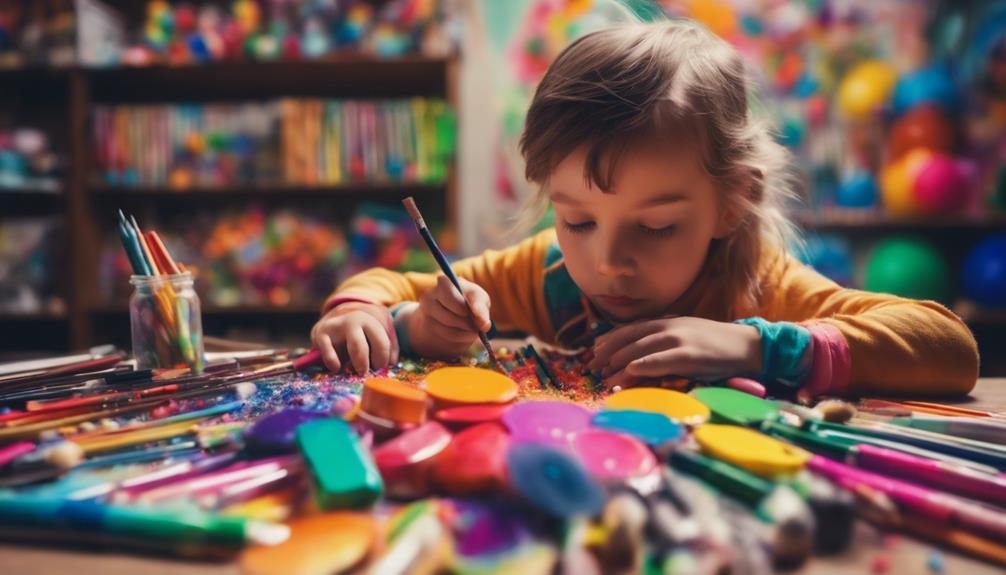
Creativity plays a significant role in childhood development, nurturing young minds to think outside the box and explore endless possibilities.
Encouraging creative expression in children is like planting seeds of imagination that bloom into beautiful ideas and innovative thinking.
When children engage in creative activities, whether it be drawing, storytelling, or building with blocks, they're actively developing their imagination.
This process is important as it helps them learn to problem-solve, think critically, and express themselves in unique ways.
Setting Up a Creative Environment
Creating a space that sparks imagination and fosters exploration is key to nurturing creativity in young children. Here are some tips to help you set up a creative environment for your little ones:
- Creative Corner: Designate a special area in your home as a creative corner where your child can engage in DIY projects. Stock it with art supplies, recycled materials, and open-ended toys to encourage free expression and experimentation.
- Sensory Exploration: Incorporate sensory elements like playdough, sand, water, or textured materials to stimulate your child's senses and inspire creativity through touch, smell, and sight.
- Imaginative Play: Create different play zones such as a dress-up corner, a puppet theater, or a building block station to encourage imaginative play. Rotate toys and props regularly to keep the space fresh and exciting for your child.
Embracing Unstructured Play
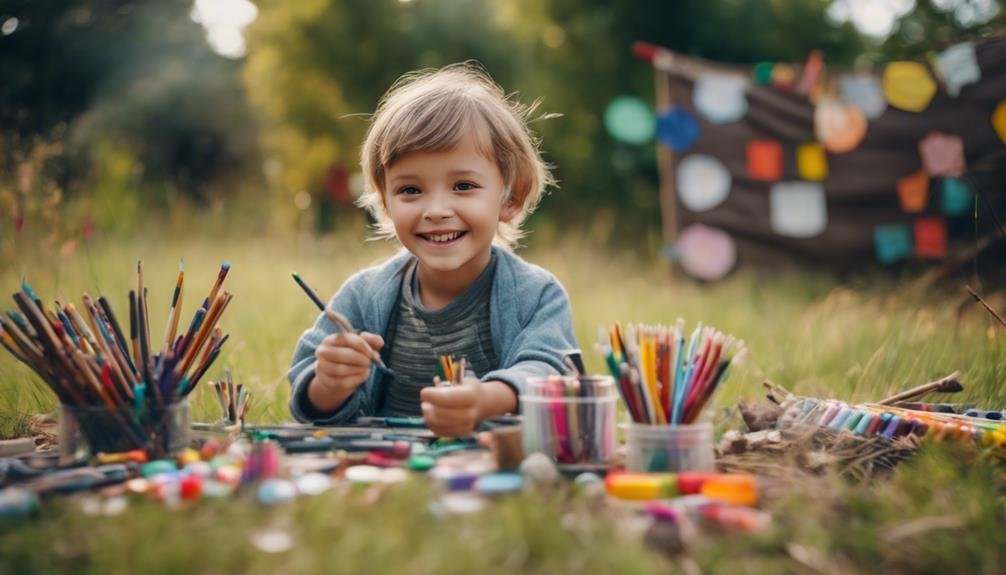
To nurture creativity in young children, embracing unstructured play as an important opportunity for exploration and self-discovery is vital. Outdoor exploration and imaginative play are essential components in fostering creativity. Encouraging your little ones to engage in unstructured play allows them the freedom to follow their curiosity and make their own rules.
Whether it's building forts in the backyard, pretending to be pirates on a treasure hunt, or simply running around in open spaces, unstructured play provides a canvas for their imagination to run wild.
Unstructured play outdoors not only stimulates creativity but also promotes physical activity and a deeper connection with nature. It encourages children to think outside the box, problem-solve independently, and develop a sense of autonomy.
Incorporating Arts and Crafts
As your child explores the wonders of unstructured play outdoors, consider incorporating arts and crafts to further ignite their imagination and creativity. Engaging in DIY projects and sensory play can open up a world of possibilities for your little one. Here are some ideas to get you started:
- DIY Projects: Encourage your child to get hands-on with creating their own masterpieces. From building a bird feeder to designing their own jewelry, the possibilities are endless. DIY projects not only enhance creativity but also boost problem-solving skills.
- Recycled Materials: Utilizing recycled materials in arts and crafts not only teaches your child about sustainability but also sparks creativity. Challenge them to create art pieces using items that would typically be thrown away.
- Process Art: Embrace the beauty of the artistic process rather than focusing solely on the end product. Allow your child to explore different textures, colors, and techniques without the pressure of creating something perfect. Process art encourages experimentation and self-expression, nurturing their creative spirit.
Encouraging Storytelling and Writing
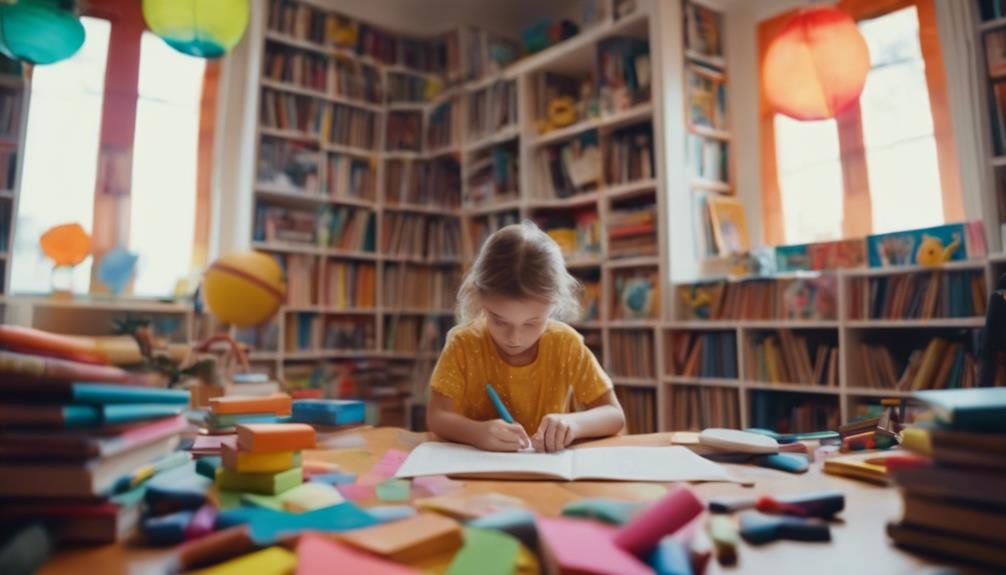
Nurture your child's storytelling and writing skills by encouraging them to weave their imaginative tales and pen down their thoughts creatively. Engaging in imaginative play can be a fantastic way to inspire your little one's creativity. Encourage them to create stories about magical lands, brave heroes, or talking animals. To further enhance their writing abilities, provide them with journal prompts to kickstart their storytelling journey. Here's a helpful table to guide you in nurturing your child's storytelling and writing skills:
| Imaginative Play | Journal Prompts |
|---|---|
| Create a make-believe world and characters | Write about a time you felt incredibly brave |
| Act out a favorite story and give it a twist | Describe a place you've never been to, but dream about |
| Use props like costumes or puppets to enhance storytelling | Invent a new creature and write a short story about it |
| Play a storytelling game where each person adds a sentence to the story | Reflect on a happy memory and write about why it's special |
Encouraging your child to engage in storytelling and writing not only fosters their creativity but also helps them develop important communication and literacy skills.
Exploring Music and Dance
Curiously, have you ever considered how exploring music and dance can ignite your child's creativity and joy? Music and dance offer a vibrant and engaging way for children to express themselves and connect with their emotions. Here are three ways these art forms can nurture your child's creativity:
- Rhythmic Movement: Encouraging your child to move to the rhythm of music can help them develop coordination, balance, and a sense of timing. Whether it's swaying to a gentle melody or jumping to an upbeat tune, rhythmic movement allows children to explore different ways of expressing themselves physically.
- Musical Expression: Introducing your child to a variety of musical styles and instruments can spark their imagination and inspire creativity. From banging on drums to tinkling on a xylophone, musical expression provides a sensory-rich experience that stimulates the brain and encourages experimentation.
- Emotional Connection: Music and dance offer a unique outlet for children to express their feelings and connect with others. Whether they're dancing joyfully to a favorite song or creating a melody that reflects their mood, these art forms help children develop emotional intelligence and empathy.
Exploring music and dance can be a joyful and enriching experience for your child, fostering their creativity and self-expression in a playful and engaging way.
Nature-Inspired Creativity
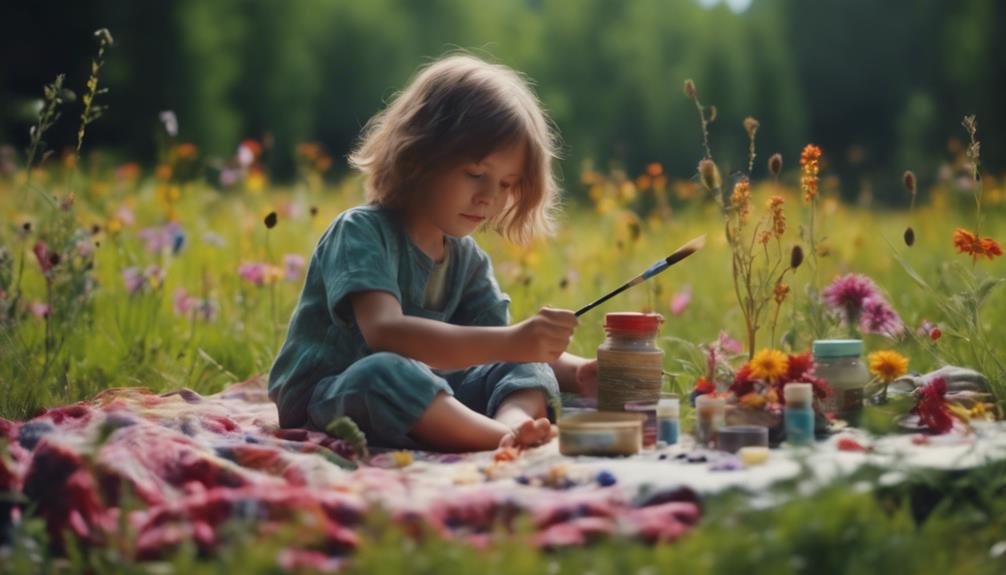
Immerse your child in the wonders of nature to spark their creativity and imagination effortlessly. Outdoor exploration can be a treasure trove of inspiration for young minds. Encourage your little one to touch the rough bark of a tree, listen to the chirping birds, and feel the cool breeze on their face. These sensory activities not only connect them to the natural world but also stimulate their senses, laying a strong foundation for creative thinking.
Take your child on a nature walk and let them collect leaves, rocks, or flowers. Back home, these treasures can become materials for arts and crafts projects. Encourage your child to observe the intricate details of a flower petal or the patterns on a leaf; then, watch as their imagination runs wild, turning these observations into beautiful creations.
Technology as a Creative Tool
Let technology be your child's canvas for boundless creativity and innovation. With the right guidance and tools, your little one can explore a world where imagination meets technology seamlessly. Here are a few ways technology can foster creativity in young minds:
- Digital Storytelling: Encourage your child to create their own stories using digital tools. They can combine images, sounds, and text to craft imaginative narratives that come to life on screen.
- Interactive Learning: Utilize interactive apps and programs that engage your child in hands-on learning experiences. From math games to science simulations, technology offers a dynamic way for kids to explore and understand various subjects.
- Coding for Kids, Tech Artistry: Introduce your child to the basics of coding and watch as they develop problem-solving skills and unleash their creativity through tech artistry. From designing games to creating animations, coding opens up a world of possibilities for young creators.
Embrace the merging of technology and creativity in your child's life, and watch as they flourish in the digital age.
Celebrating and Encouraging Mistakes
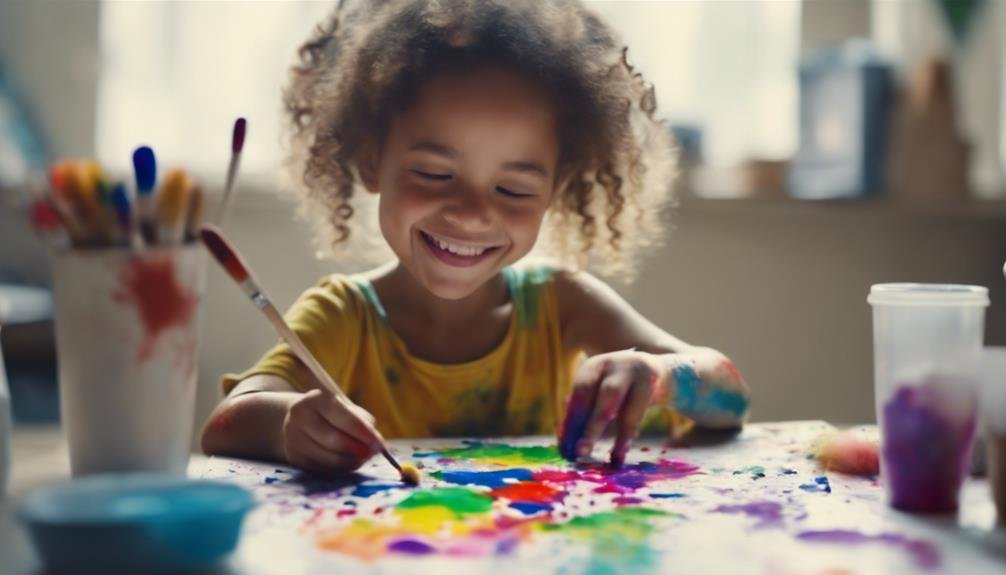
Embrace the beauty of learning through mistakes as your child navigates the path of creativity and growth. It's crucial to celebrate and encourage mistakes as they provide invaluable learning opportunities. When your child makes a mistake, it isn't a failure but a chance to grow and improve. By adopting a growth mindset, they understand that setbacks are stepping stones to success.
Mistakes help children develop resilience and problem-solving skills. Encourage them to see errors as part of the creative process, rather than something to be ashamed of. Praise their efforts and highlight the lessons they can learn from their mistakes.
Frequently Asked Questions
How Can Parents Help Children Overcome Fear of Failure and Perfectionism When It Comes to Being Creative?
When helping kids tackle fear of failure and perfectionism in creativity, it's significant to encourage exploration and build confidence. Celebrate their efforts, not just the outcomes. Let them know mistakes are part of learning and growing.
Are There Specific Strategies for Fostering Creativity in Children With Learning Disabilities or Special Needs?
In fostering creativity for children with learning disabilities or special needs, you can create individualized approaches tailored to their unique strengths. Embrace inclusive environments, use differentiated instruction, and offer positive reinforcement to nurture their creative spark.
What Role Do Cultural Differences Play in Nurturing Creativity in Young Children?
In nurturing creativity in young children, cultural influences can shape their creative environments. Celebrate diverse perspectives and traditions. Encourage exploration of different art forms and storytelling methods. Embrace the richness of cultural diversity to inspire imaginative expression.
How Can Parents Balance Encouraging Creativity With Setting Boundaries and Rules for Their Children?
When nurturing creativity in young children, setting boundaries is key. Encourage independence by allowing them to explore within limits. Offer guidance and support while also giving them room to express themselves freely.
Are There Any Potential Negative Effects of Focusing Too Much on Fostering Creativity in Young Children?
Sometimes, too much focus on fostering creativity in young ones can lead to challenges like struggling with boundaries or developing perfectionist tendencies. Remember, balance is key to nurturing creativity effectively.
Conclusion
You may worry that nurturing creativity in young children will be messy or chaotic, but remember that creativity thrives in a space where mistakes are celebrated and exploration is encouraged.
By providing a creative environment filled with arts, crafts, music, and nature, you're helping children develop essential skills for their future success.
Embrace the mess and let your child's imagination soar – the benefits will far outweigh any temporary chaos.




